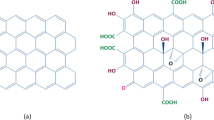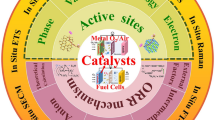Abstract
Zinc oxide and graphene support as catalyst were synthesized and characterized using different techniques. Results showed that graphene presented thermal stability, and maintained its structure under heat treatment at temperatures of 500 °C. TPD He experiments showed decomposition of residual compounds, releasing oxygenated compounds after functionalization of the graphene oxide. The catalyst performance was evaluated for the reaction of CH4 + CO2 and O2 by surface reaction at programmed temperature. We observed the formation of CO, H2 and H2O. However, TPSR and DRIFTS coupled to a mass spectrometer evidenced methane activation on ZnO/rGO-T, due to the evolution of H2 and CO2 traces of water and hydrocarbons, such as ethane (C2H6). Less sensitive but present was the signal 60, which can be assigned to the formation of acetic acid (CH3COOH) at 300 °C.
Graphical Abstract



















Similar content being viewed by others
References
Wilcox EM, Roberts GW, Spivey JJ (2003) Direct catalytic formation of acetic acid from CO2 and methane. Catal Today 88(1–2):83–90. https://doi.org/10.1016/j.cattod.2003.08.007
Havran V, Dudukovic MP, Lo CS (2011) Conversion of methane and carbon dioxide to higher value products. Ind Eng Chem Res 50(12):7089–7100. https://doi.org/10.1021/ie2000192
Wilcox EM, Gogate MR, Roberts GW, Spivey JJ (2001) Direct synthesis of acetic acid from methane and carbon dioxide. In: Spivey JJ, Iglesia E, Fleisch TH (eds) Studies in surface science and catalysis, vol 136. Elsevier, Berlin, pp 259–264. https://doi.org/10.1016/S0167-2991(01)80313-X
Huang W, Sun WZ, Li F (2009) Efficient synthesis of ethanol and acetic acid from methane and carbon dioxide with a continuous, stepwise reactor. AIChE J 56(5):1279–1284. https://doi.org/10.1002/aic.12073
Spivey JJ, Wilcox EM, Roberts GW (2008) Direct utilization of carbon dioxide in chemical synthesis: vinyl acetate via methane carboxylation. Catal Commun 9(5):685–689. https://doi.org/10.1016/j.catcom.2007.08.023
Wu J-F, Yu S-M, Wang WD et al (2013) Mechanistic insight into the formation of acetic acid from the direct conversion of methane and carbon dioxide on zinc-modified H-ZSM-5 zeolite. J Am Chem Soc 135(36):13567–13573. https://doi.org/10.1021/ja406978q
Patil U, Saih Y, Abou-Hamad E et al (2014) Low temperature activation of methane over a zinc-exchanged heteropolyacid as an entry to its selective oxidation to methanol and acetic acid. Chem Commun 50(82):12348–12351. https://doi.org/10.1039/C4CC04950K
Julkapli NM, Bagheri S (2015) Graphene supported heterogeneous catalysts: an overview. Int J Hydrog Energy 40(2):948–979. https://doi.org/10.1016/j.ijhydene.2014.10.129
Navalon S, Dhakshinamoorthy A, Alvaro M et al (2016) Metal nanoparticles supported on two-dimensional graphenes as heterogeneous catalysts. Coord Chem Rev 312:99–148. https://doi.org/10.1016/j.ccr.2015.12.005
Machado BF, Serp P (2012) Graphene-based materials for catalysis. Catal Sci Technol 2(1):54–75. https://doi.org/10.1039/C1CY00361E
Novoselov KS, Geim AK, Morozov SV et al (2004) Electric field effect in atomically thin carbon films. Science 306(5696):666–669. https://doi.org/10.1126/science.1102896
Marcano DC, Kosynkin DV, Berlin JM et al (2010) Improved synthesis of graphene oxide. ACS Nano 4(8):4806–4814. https://doi.org/10.1021/nn1006368
Fernández-Merino MJ, Guardia L, Paredes JI et al (2010) Vitamin C is an ideal substitute for hydrazine in the reduction of graphene oxide suspensions. J Phys Chem C 114(14):6426–6432. https://doi.org/10.1021/jp100603h
Vega-Poot AG, Rodríguez-Gattorno G, Soberanis-Domínguez OE et al (2010) The nucleation kinetics of ZnO nanoparticles from ZnCl2 in ethanol solutions. Nanoscale 2(12):2710–2717. https://doi.org/10.1039/C0NR00439A
Sing K, Everett DH, Haul RAW et al (1985) IUPAC reporting physisorption data for gas/solid systems with special reference to the determination of surface area and porosity. Pure Appl Chem 57(4):603–619. https://doi.org/10.1351/pac198557040603
Stankovich S, Dikin DA, Piner RD et al (2007) Synthesis of graphene-based nanosheets via chemical reduction of exfoliated graphite oxide. Carbon 45(7):1558–1565. https://doi.org/10.1016/j.carbon.2007.02.034
Schmal M (2016) Heterogeneous catalysis and its industrial applications. Springer, Rio de Janeiro. https://doi.org/10.1007/978-3-319-09250-8
Huh SH (2011) Thermal reduction of graphene oxide. In: Mikhailov S (ed) Physics and applications of graphene—experiments. IntechOpen, London, pp 73–90. https://doi.org/10.5772/14156
Du Q, Zheng M, Zhang L et al (2010) Preparation of functionalized graphene sheets by a low-temperature thermal exfoliation approach and their electrochemical supercapacitive behaviors. Electrochim Acta 55(12):3897–3903. https://doi.org/10.1016/j.electacta.2010.01.089
Andonovic B, Temkov M, Ademi A et al (2014) Laue functions model vs Scherrer equation in determination of graphene layers number on the ground of XRD data. J Chem Technol Metall 49(6):545–550
McMurdie HF, Morris MC, Evans EH et al (1986) Standard X-ray diffraction powder from the JCPDS Research Associateship. Powder Diffr 1(2):334–345. https://doi.org/10.1017/S0885715600011593
Pimenta MA, Dresselhaus G, Dresselhaus MS et al (2007) Studying disorder in graphite-based systems by Raman spectroscopy. Phys Chem Chem Phys 9(11):1276–1291. https://doi.org/10.1039/B613962K
Biscardi JA, Meitzner GD, Iglesia E (1998) Structure and density of active Zn species in Zn/H-ZSM5 propane aromatization catalysts. J Catal 179(1):192–202. https://doi.org/10.1006/jcat.1998.2177
Oda A, Torigoe H, Itadani A et al (2014) An important factor in CH4 activation by Zn ion in comparison with Mg ion in MFI: the superior electron-accepting nature of Zn2+. J Phys Chem C 118(28):15234–15241. https://doi.org/10.1021/jp5013413
Gabrienko AA, Arzumanov SS, Luzgin MV et al (2015) Methane activation on Zn2+-exchanged ZSM-5 zeolites. The effect of molecular oxygen addition. J Phys Chem C 119(44):24910–24918. https://doi.org/10.1021/acs.jpcc.5b08759
Scarano D, Bertarione S, Spoto G et al (2001) FTIR spectroscopy of hydrogen, carbon monoxide, and methane adsorbed and co-adsorbed on zinc oxide. Thin Solid Films 400(1–2):50–55. https://doi.org/10.1016/S0040-6090(01)01472-9
Galhotra P (2010) Carbon dioxide adsorption on nanomaterials. PhD Thesis, University of Iowa https://ir.uiowa.edu/cgi/viewcontent.cgi?article=1855&context=etd
Saussey J, Lavalley J-C, Bovet C (1982) Infrared study of CO2 adsorption on ZnO. Adsorption sites. J Chem Soc Faraday Trans 1 78(5):1457–1463. https://doi.org/10.1039/F19827801457
Hussain G (2009) Oxidation of CO by O2 over ZnO studied by FTIR spectroscopy. J Chem Soc Pak 31(5):718–725. https://www.jcsp.org.pk/ArticleUpload/341-1351-1-CE.pdf
Davydov A (2003) Molecular spectroscopy of oxide catalyst surfaces. Wiley, Chichester. https://doi.org/10.1002/0470867981
Kazansky VB, Serykh AI, Pidko EA (2004) DRIFT study of molecular and dissociative adsorption of light paraffins by HZSM-5 zeolite modified with zinc ions: methane adsorption. J Catal 225(2):369–373. https://doi.org/10.1016/j.jcat.2004.04.029
Acknowledgements
The authors acknowledge São Paulo Research Foundation (FAPESP), grant 2014/27317-7, and National Council for Scientific and Technological Development (CNPq) for financial support. The authors acknowledge Nucleus of Catalysis (NUCAT/COPPE/UFRJ) in particular Dr. R. Bonfim and the Chemistry Institute of the University of São Paulo for providing the analytical facilities and technical support.
Author information
Authors and Affiliations
Corresponding author
Ethics declarations
Conflict of interest
The authors claim no conflict of interest.
Rights and permissions
About this article
Cite this article
Dutra, M., Schmal, M. & Guardani, R. Syntheses and Characterization of Zinc Oxide Nanoparticles on Graphene Sheets: Adsorption-Reaction In Situ DRIFTS of Methane and CO2. Catal Lett 148, 3413–3430 (2018). https://doi.org/10.1007/s10562-018-2538-6
Received:
Accepted:
Published:
Issue Date:
DOI: https://doi.org/10.1007/s10562-018-2538-6




